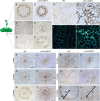A point mutation in the kinase domain of CRK10 leads to xylem vessel collapse and activation of defence responses in Arabidopsis
- PMID: 36869735
- PMCID: PMC10199123
- DOI: 10.1093/jxb/erad080
A point mutation in the kinase domain of CRK10 leads to xylem vessel collapse and activation of defence responses in Arabidopsis
Abstract
Cysteine-rich receptor-like kinases (CRKs) are a large family of plasma membrane-bound receptors ubiquitous in higher plants. However, despite their prominence, their biological roles have remained largely elusive so far. In this study we report the characterization of an Arabidopsis mutant named crk10-A397T in which alanine 397 has been replaced by a threonine in the αC helix of the kinase domain of CRK10, known to be a crucial regulatory module in mammalian kinases. The crk10-A397T mutant is a dwarf that displays collapsed xylem vessels in the root and hypocotyl, whereas the vasculature of the inflorescence develops normally. In situ phosphorylation assays with His-tagged wild type and crk10-A397T versions of the CRK10 kinase domain revealed that both alleles are active kinases capable of autophosphorylation, with the newly introduced threonine acting as an additional phosphorylation site in crk10-A397T. Transcriptomic analysis of wild type and crk10-A397T mutant hypocotyls revealed that biotic and abiotic stress-responsive genes are constitutively up-regulated in the mutant, and a root-infection assay with the vascular pathogen Fusarium oxysporum demonstrated that the mutant has enhanced resistance to this pathogen compared with wild type plants. Taken together our results suggest that crk10-A397T is a gain-of-function allele of CRK10, the first such mutant to have been identified for a CRK in Arabidopsis.
Keywords: Fusarium oxysporum; Arabidopsis; cysteine-rich receptor-like kinase CRK10; defence response; gain-of-function mutation; kinase regulation; transcriptomics; xylem vessel collapse; αC helix.
© The Author(s) 2023. Published by Oxford University Press on behalf of the Society for Experimental Biology.
Conflict of interest statement
The authors have no conflicts of interest to declare.
Figures







Similar articles
-
More questions than answers: insights into potential cysteine-rich receptor-like kinases redox signalling in Arabidopsis.Plant J. 2025 Apr;122(2):e70176. doi: 10.1111/tpj.70176. Plant J. 2025. PMID: 40300149 Free PMC article. Review.
-
A Genetic Screen Identifies a Requirement for Cysteine-Rich-Receptor-Like Kinases in Rice NH1 (OsNPR1)-Mediated Immunity.PLoS Genet. 2016 May 13;12(5):e1006049. doi: 10.1371/journal.pgen.1006049. eCollection 2016 May. PLoS Genet. 2016. PMID: 27176732 Free PMC article.
-
A Cysteine-Rich Protein Kinase Associates with a Membrane Immune Complex and the Cysteine Residues Are Required for Cell Death.Plant Physiol. 2017 Jan;173(1):771-787. doi: 10.1104/pp.16.01404. Epub 2016 Nov 16. Plant Physiol. 2017. PMID: 27852951 Free PMC article.
-
Activation of hypersensitive cell death by pathogen-induced receptor-like protein kinases from Arabidopsis.Plant Mol Biol. 2004 Sep;56(2):271-83. doi: 10.1007/s11103-004-3381-2. Plant Mol Biol. 2004. PMID: 15604743
-
Cysteine-rich receptor-like protein kinases: emerging regulators of plant stress responses.Trends Plant Sci. 2023 Jul;28(7):776-794. doi: 10.1016/j.tplants.2023.03.028. Epub 2023 Apr 26. Trends Plant Sci. 2023. PMID: 37105805 Review.
Cited by
-
More questions than answers: insights into potential cysteine-rich receptor-like kinases redox signalling in Arabidopsis.Plant J. 2025 Apr;122(2):e70176. doi: 10.1111/tpj.70176. Plant J. 2025. PMID: 40300149 Free PMC article. Review.
-
Herbivory-induced green leaf volatiles increase plant performance through jasmonate-dependent plant-soil feedbacks.Nat Plants. 2025 May;11(5):1001-1017. doi: 10.1038/s41477-025-01987-x. Epub 2025 May 1. Nat Plants. 2025. PMID: 40312547
-
RNA-seq analyses on gametogenic tissues of alfalfa (Medicago sativa) revealed plant reproduction- and ploidy-related genes.BMC Plant Biol. 2024 Sep 3;24(1):826. doi: 10.1186/s12870-024-05542-2. BMC Plant Biol. 2024. PMID: 39227784 Free PMC article.
-
Cell-type-specific response to silicon treatment in soybean leaves revealed by single-nucleus RNA sequencing and targeted gene editing.Plant J. 2025 Jul;123(1):e70309. doi: 10.1111/tpj.70309. Plant J. 2025. PMID: 40591895 Free PMC article.
-
Genetic Determinants of Fiber-Associated Traits in Flax Identified by Omics Data Integration.Int J Mol Sci. 2022 Nov 22;23(23):14536. doi: 10.3390/ijms232314536. Int J Mol Sci. 2022. PMID: 36498863 Free PMC article.
References
-
- Acharya BR, Raina S, Maqbool SB, Jagadeeswaran G, Mosher SL, Appel HM, Schultz JC, Klessig DF, Raina R.. 2007. Overexpression of CRK13, an Arabidopsis cysteine-rich receptor-like kinase, results in enhanced resistance to Pseudomonas syringae. The Plant Journal 50, 488–499. - PubMed
-
- Ahuja I, Kissen R, Bones AM.. 2012. Phytoalexins in defense against pathogens. Trends in Plant Sciences 17, 73–90. - PubMed
-
- Bacete L, Melida H, Miedes E, Molina A.. 2018. Plant cell wall-mediated immunity: cell wall changes trigger disease resistance responses. The Plant Journal 93, 614–636. - PubMed
-
- Beenstock J, Mooshayef N, Engelberg D.. 2016. How do protein kinases take a selfie (autophosphorylate)? Trends in Biochemical Sciences 41, 938–953. - PubMed

